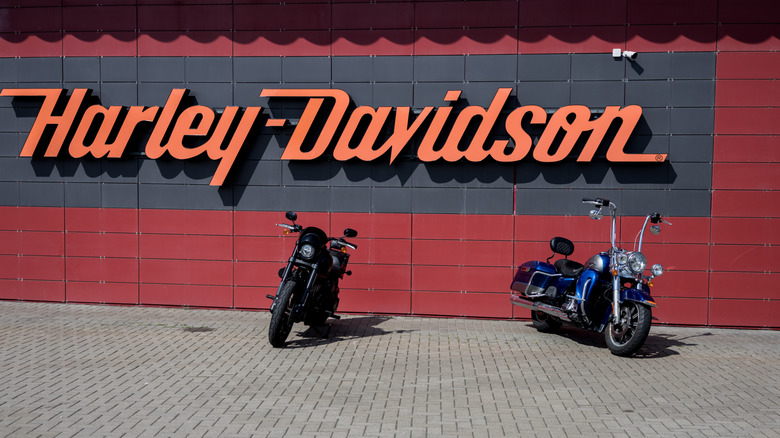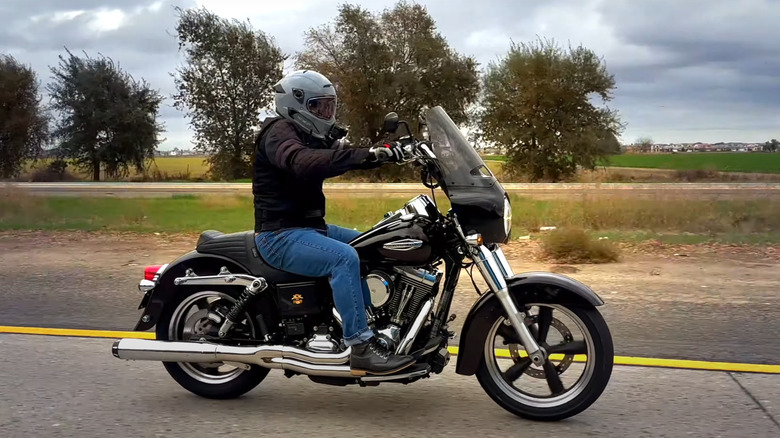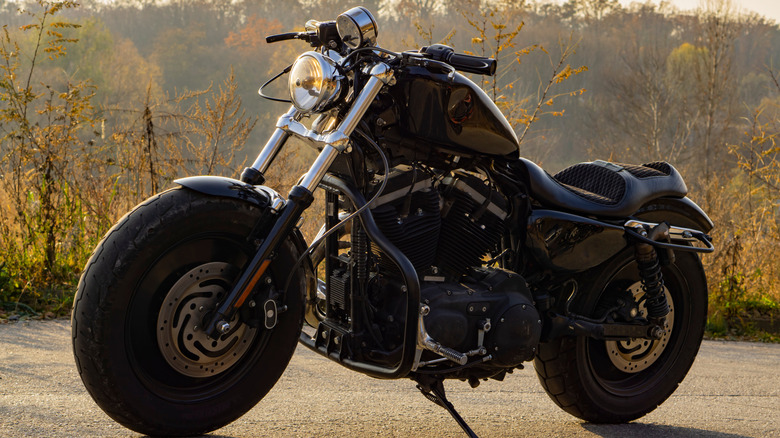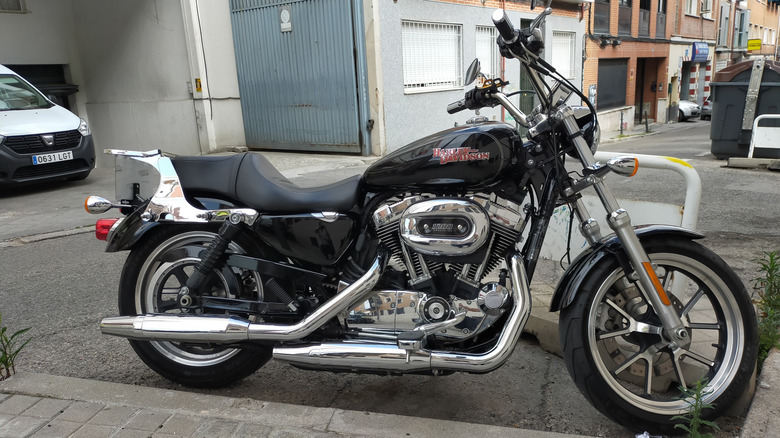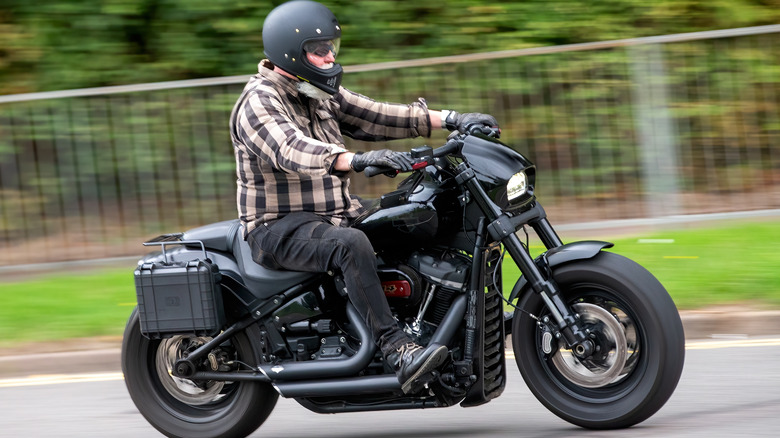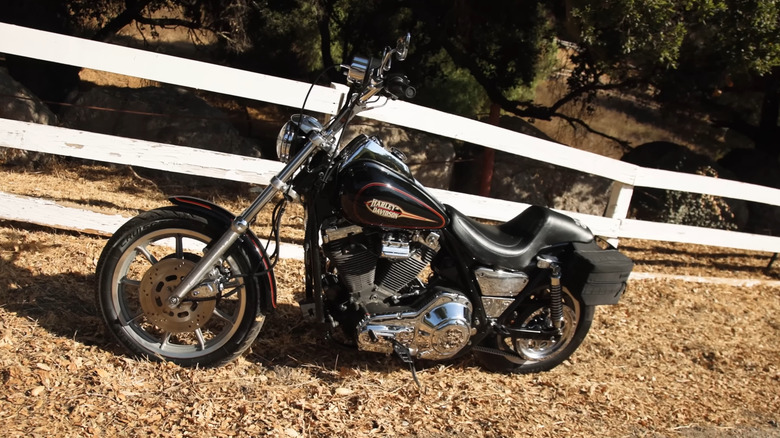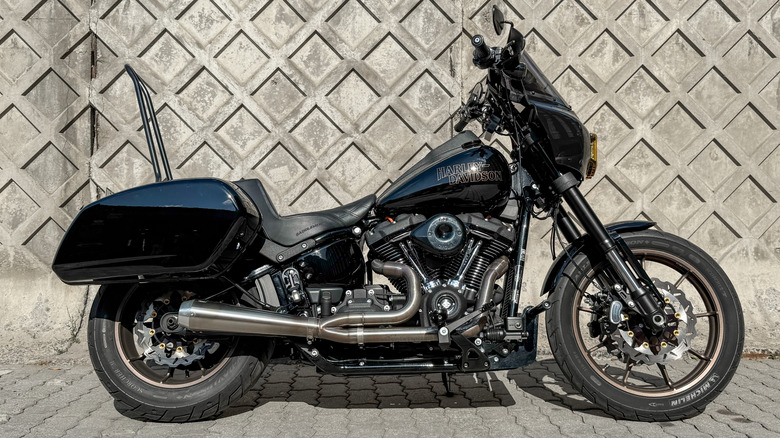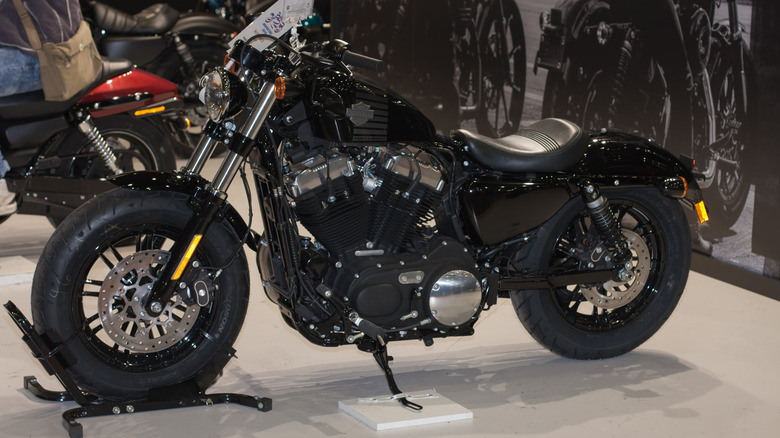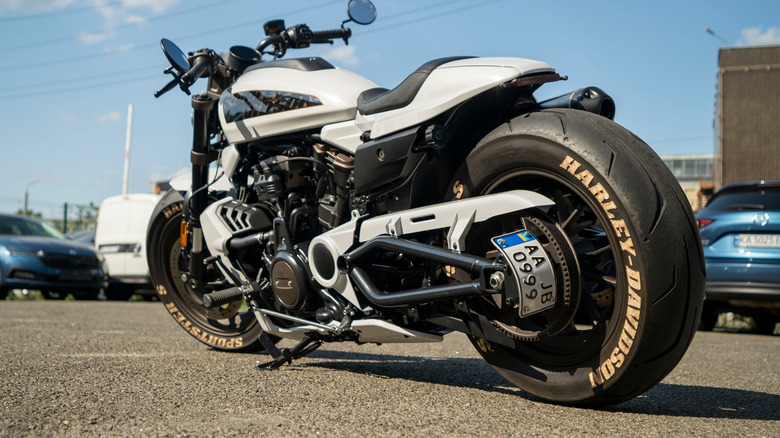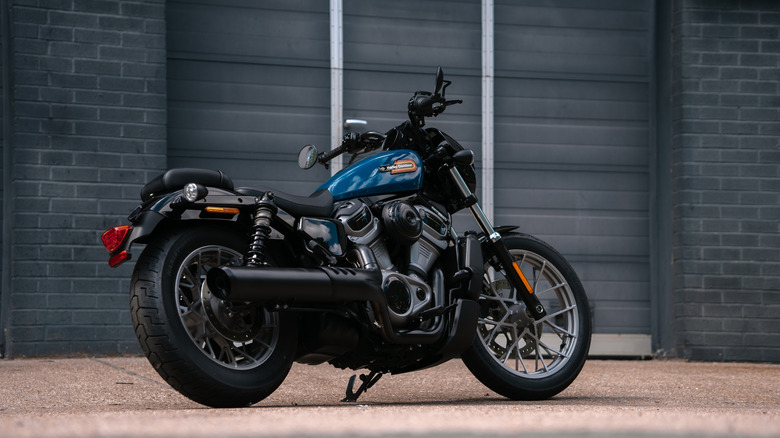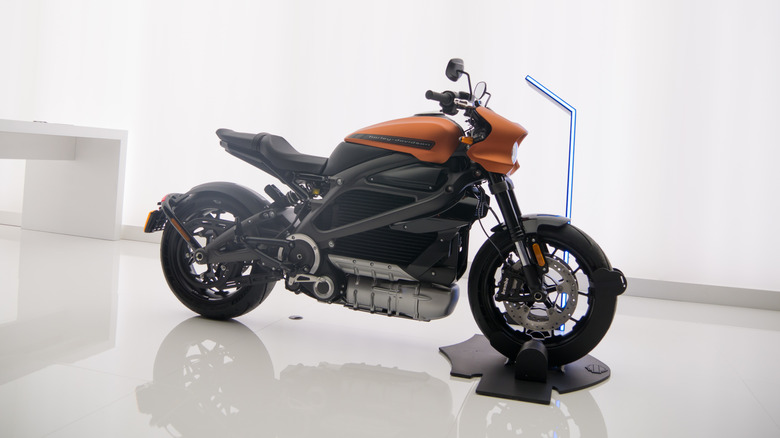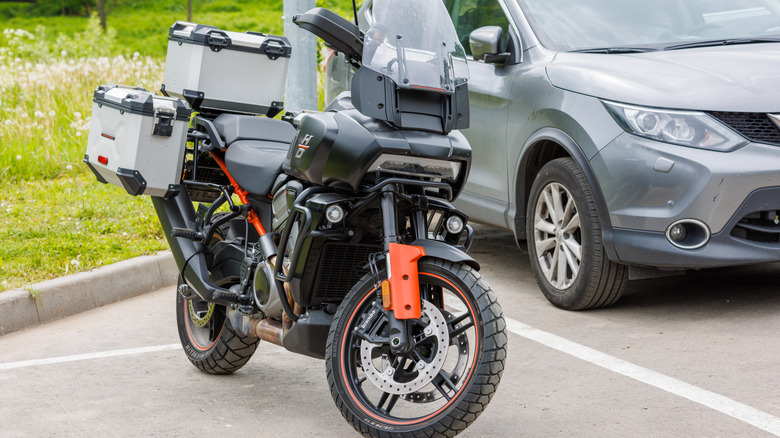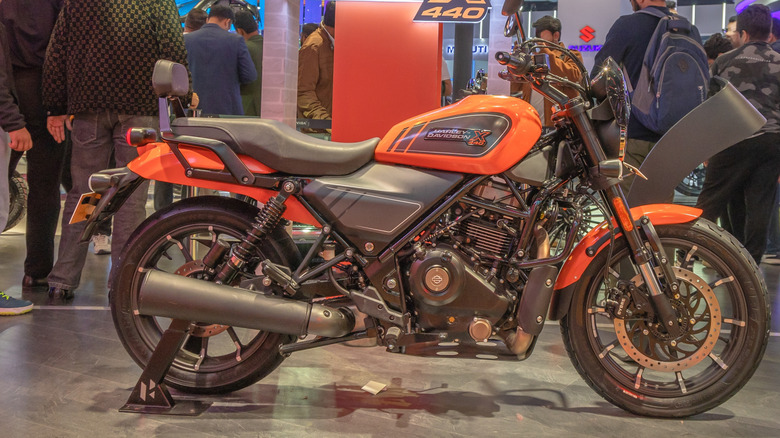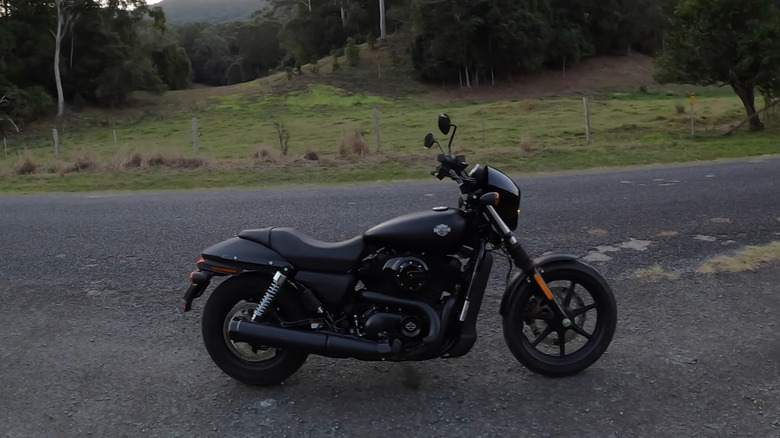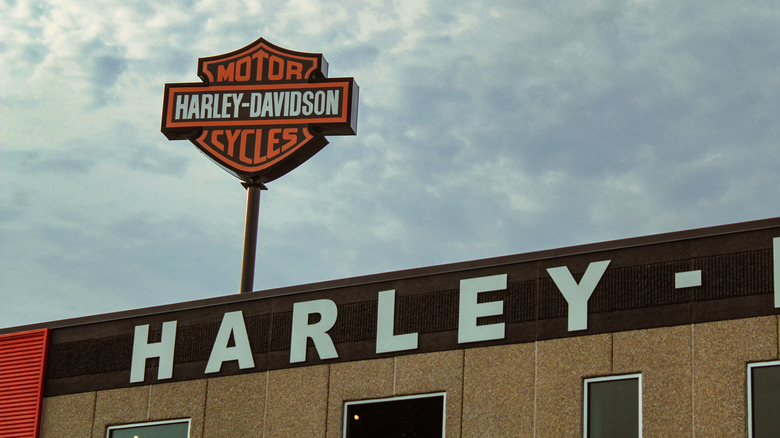13 Of The Best-Handling Harley-Davidsons Ever Made
Throughout the history of Harley-Davidson, the words "best handling" have seldom been used to describe the brand's bikes without considerable heated debate following. For the longest time, Harley-Davidson has focused on making extremely heavy and comfortable bikes that aren't exactly known for their agility. However, that's not to say certain iconic Harley models aren't good at handling; quite the opposite really. Sure, if you try to take an Electra Glide up a twisting mountain road, and it'll feel like trying to convince a battleship to change direction, but certain models definitely have a sporty feel to them.
Harley bikes that handle mostly seem to share the same characteristics. Lighter weights make these bikes more agile, a lower seat height reduces the center of gravity, narrower tires allow for better turns with smaller contact patches, and better suspension improves the handling without grounding out a foot peg. Here are 13 such examples.
Dyna Switchback
The Dyna Switchback was a rather unique offering for the early 2010s, and aptly named. It featured saddle bags that were the same color as the paintwork, which was perceived as quite cool – and yeah, our standards as consumers were quite low back then. But that points to the fact that the buyer was practically begging for some sort of innovation, which the Switchback delivered. It allowed the rider to detach the windscreen from the handlebars, turning the bike from cruiser to tourer in an instant. Many reviewers who were hands-on with the bike at the time harped on about its amazing handling, and how it was the perfect middle ground between cruising and touring.
The tires were a bit of an odd specification — 160/70 at the rear and 130/70 at the front. Furthermore, as had become industry standard for touring bikes by the era, the rear suspension preload was adjustable, so the ride could be fine tuned a fair bit. Power came courtesy of the then-new 103 engine from Milwaukee House that displaced 1,690cc across two cylinders, making 97 lb-ft of torque from as low as 3,000 RPM. Readers should note that it was about this time that Harley was phasing out the by-now-underpowered Twin Cam 96 engine that had been standard in most touring models.
Iron 883
Harley-Davidson's in-house experts claim that the Iron 883 is among the best motorcycles for short riders; and that should tell us all we need to know. It has been around for some time, having launched in 2009 with the Evolution engine. The modern generation (from 2015 and newer) is a pretty good mix of looks and handling prowess, though it does tend to feel a bit underpowered for highway riding, according to some accounts. The engine in this modern generation of Sportster 883 is the Evo from Milwaukee House that displaces 883cc across the same legendary V-twin layout cylinders that the industry has come to love. The power figures on the 883 are a bit underwhelming, as we mentioned, coming in at 46 hp and 55 lb-ft of torque. With its slammed suspension, seat height of 26.9 inches above the ground, and slim tire profile (100/90 front, 150/80 rear), it's a pity that Harley-Davidson discontinued it.
Iron 1200
The Iron 883's under-powering was fixed by the Iron 1200, another version from the Sportster lineup, in the most American way possible: Keep everything else the same, stuff a bigger engine with more horsepower alongside the existing components, and hope everything works out. And to a large extent, everything did work out. The bigger engine displaces 1,202cc across the same two cylinders, but with the added displacement the power for this model now sits at a far more respectable 81 hp and 70 lb-ft of torque from 3,700 RPM.
The weight does go up a tiny bit, with the 1200 coming in at 553 pounds versus the 883's 548 pounds, but that's more than offset by the additional grunt from the larger powerplant. In the looks department the Iron 1200 also beats out the 883, arguably, since the engine area looks a lot more filled in, and not like it's lacking something.
Fat Bob Sport
While the Fat Bob has gained its rightful place in history as one of the best-looking Harley-Davidson motorcycles ever to be made, it's not exactly the best at handling — but then again, very few things with the word "fat" in their name are. However, all that would change when the mad scientists at Harley-Davidson decided to release a "sport" trim of the bike, with model designation FXFBS. It debuted in 2018 as a 2019 model, and kept much of the same design language that made the original Fat Bob great, but added a bigger engine, and some other bits and bobs here and there.
In FXFBS, the first two letters indicate a big V-twin layout of the engine (F) and that it is a sport model (X) to begin with. Then, the next two letters (FB) are simply an acronym for Fat Boy. And lastly, the S designation indicates that it was a special model; special because the FXFBS came with the Milwaukee 114 engine; as opposed to the Milwaukee 107 that the FXFB shipped with.
This engine, as the name suggests, displaced 1,868cc, while making 93 hp and 118 lb-ft of torque from 3,500 RPM, and was paired to a six-speed transmission. Coupled with the small size of the Fat Bob, and lower-than-average-Harley weight of 653 pounds, it is the perfect middle ground between handling and cruising.
FXRS Low Rider
Some people claim that the FXRS Low Rider is the best-handling Harley Davidson motorbike of all time, period. There's certainly some merit to that claim, as it follows the formula for a bike with proper handling that we detailed above almost to a T. A low seat height, thinner than usual tires, fairly upright seating position, and a shorter than normal wheelbase all add up make the FXRS Low Rider one of the best handling bikes of all time, at least from a cruiser/ touring perspective. In addition, reviewers have also made note of the exceptional comfort of the Low Rider, which is a big thing, as most bikes of the time were slotted into either the performance or the comfort category, never both.
The FXR line of bikes based on the platform of the same name all fall into the category of Harleys that handle well, but the FXRS Low Rider is certainly one of, if not the best in that regard. Power comes from the legendary Harley-Davidson Evolution engine that displaces 1,337cc across two cylinders, making 67 hp and 67 lb-ft of torque. This would deliver power to the rear wheel via chain final drive and a four-speed transmission, making for not just a sporty but also an engaging ride overall.
FXLRS Low Rider
For purists, the FXRS Low Rider that we covered above is the go-to choice, but for people who want more power and performance without having to drop in a Harley-Davidson crate engine, the modern Low Rider is the better choice. A key difference is that the newer-gen now uses the Harley-Davidson Softail platform as a base, which has a number of benefits. People, especially mechanics are familiar with the platform and its quirks, major spare parts are relatively easier to source, and the mods / aftermarket scene is quite vibrant.
It comes with more tech, newer materials, updated features, better aftermarket support and of course, warranty – in some cases. The model code follows the same logic that we outlined above; with F meaning it's a big-twin, X meaning it's a sport unit, and LR meaning Low Rider, with the S or ST at the end as applicable. Modern units ship with a Screamin' Eagle engine that is 1,801cc in size, providing 77 hp and 115 lb-ft of torque on tap, mated to a six-speed transmission.
Sportster Forty-Eight
A cousin of the Iron 883 and Iron 1200 that we covered above, the Forty-Eight is also from the Sportster line from Harley-Davidson. As the name suggests, this entire line of bikes is meant to be more responsive and exciting to ride when compared to other models that prioritize comfort and long-distance rides. The Forty-Eight is shorter than most other offerings from Milwaukee House, coming in at 85 inches long, and it has one of the lowest seat heights too, at just 28 inches above the ground.
This lets riders get a properly flat-foot-down ride, which would give novice riders more confidence when out and about. Power comes courtesy the now-legendary Harley air-cooled Evolution engine that displaces 1,202cc across its V-twin layout cylinders, making 66 hp and 71 lb-ft of torque from 3,500 RPM. This unit is mated to a five-speed transmission, and with an estimated economy of 45 mpg plus a 2.1-gallon fuel tank, riders can expect to get about 100 miles of very exciting range between fill-ups.
Sportster S
The Sportster S, particularly units that ship with the 1250T Revolution engine, are also up there among the best-handling Harley-Davidsons. With a seat height of just 30 inches above the ground — that's just 2.5 feet — the center of gravity is significantly lower than on other offerings. Couple that with the short length of the bike at 89 inches, and the sheer amount of power available on tap, and it's a recipe for success, at least in terms of handling and sportiness. The Revolution engine displaces 1,252cc across its V-twin cylinders and makes an eye-watering 121 hp and 92 lb-ft of torque; making it easy to see why it's been named the Sportster S.
The pricing isn't too bad either, with models from 2024 and 2025 running buyers about $15,999 for new units. On the aftermarket, older models from around 2021 and newer will sell for about $8,000, which isn't exactly cheap, but it's a steal as far as Harleys go.
Nightster S
Though similar to the Sportster that we covered above, the Nightster S is far less powerful when compared to the Sportster S. Some would say that this aspect of the Nightster makes it too commuter-like, but that's exactly what makes it more desirable to some buyers. For instance, the Nightster S would seem far more palatable to novice riders or for people who don't always want to max out the speed limit. Coming to the engine, it is the Revolution 975T, displacing 975cc across two cylinders, which means that it is about 33% smaller than the one on the Sportster S from earlier.
Power output figures for the Nightster S are 91 hp and 72 lb-ft of torque; delivered to the rear wheel via a six-speed transmission. Given that it is a single seat motorcycle, the Nightster S can only hold one rider, which is just as well, because another 150 pounds would mean that it would feel underpowered. The running weight of the bike is 481 pounds, which is positively light by Harley standards, but with only 72 lb-ft of torque, it can seem insufficient on the highway. However, for city riding, and for short commutes, the Nightster S is probably the most engaging Harley that is currently offered in the lineup.
LiveWire One
What initially started as a model under the Harley-Davidson banner attracted such flak from pursuits and enthusiasts alike, it was quickly spun off and detached from the Harley name altogether. We're talking, of course, about LiveWire, which exclusively makes electric motorcycles. Its first and so far only offering is a sports bike, plain and simple, and by virtue of being all-electric, it has loads of torque available from zero RPMs and up, so it's arguably the most fun bike on this list, from a performance standpoint, coming in at 100 hp or 75 kW. However, as with most current-generation electric vehicles (not just bikes), the issue lies in range, or rather, the lack of it.
While LiveWire claims 146 miles per charge and a level two charging time of 40 minutes from zero to 80%, reviewers have found the usable range to be closer to 80 or 100 miles. Of course, given that it's electric, the range would be heavily influenced by how the rider uses the throttle, and that has to be accounted for. But even that major flaw could have been overlooked if the bike was priced sensibly; and spoiler alert: it's not. At writing, a new LiveWire One would run buyers the cool sum of $16,499, at which point they can and should be looking at other models. The issue isn't about being electric, but about daylight robbery.
The Pan America Range
Harley-Davidson currently offers three adventure bikes, something that only a few ardent fans of the brand know about, and even fewer are willing to admit it. These three bikes are the Pan America Special, Pan America ST, and the Pan America CVO — the CVO stands for custom vehicle operations, and is attached to the most exclusive of the models. While there is no set rule, the ST is generally considered better suited to being used on-road, as it comes with smaller wheels (17 inches) and less suspension travel than the other two models. The Pan America Special rides on larger 19-inch wheels and has a decent bit more suspension travel, which means that riders do have a bit more flexibility to go off-road with the Special.
The CVO Pan America is simply an all-options ticked version of the Special with a (much) higher price point. Given that the line is intended to be adventure bikes, handling and lightness were given top priority. Furthermore, in terms of the engine, all three models share a powerplant with the Sportster S we covered above, the Revolution 1250T. It displaces 1,252cc across two cylinders and makes 150 hp alongside 92 lb-ft of torque from 6,750 RPM, meaning that there is plenty of rev-range headroom to get out of sticky, rocky, or muddy situations.
X440
Next up we have the Harley-Davidson X440, which is unique mainly because it is not offered stateside. The model is sold exclusively in India, and considered a mid-range bike in the market. 2025 models retail for 2,39,500 Indian Rupees — a little over $2,700 at time of writing, though this would obviously change with the exchange rate. It's not a pure sports bike, but it can't really be slotted into any other category wholly, as it is meant to be an all-rounder offering.
Power comes from a unit that displaces 440cc across a single cylinder, while being mated to a six-speed transmission that drives the rear wheel. This small engine makes just 38 lb-ft of torque alongside 27 hp. It weighs 429 pounds, and has a seat height of 32 inches. The whole package rides on 18 or 17 inch wheels, and is 85 inches long; all of which adds up to make an extremely agile, maneuverable motorcycle that is perfectly suited to the Indian market. So far, Harley has made no indication that it intends to offer the X440 in any other country, which is a pity. It seems like a bike with really great value, all things considered.
Street 500
The smaller cousin to the Street 750, the Street 500 is 87 inches long and with a seat height of just 28 inches. Many reviewers have praised its high degree of responsiveness compared to other Harley bikes. But then again, that's like comparing a Ford F-650 to a F-150 and saying that the latter is more agile. While true on a comparative basis, the F-150 is still a massive vehicle. The analogy still holds true for the Street 500, which came in at an eye-watering 514 pounds.
However, the fact remains that as far as Harley's go, it was one of the better handling ones when it released, not least because of the small but powerful engine it had. Namely, the engine was the Revolution from Milwaukee House that displaced 492cc and made 32 hp along with 30 lb-ft of torque from 3,500 RPM, paired to a six-speed transmission. The Street 500 was discontinued in 2020, and models from about 2018 are currently selling for about $4,000 on the used market.
Methodology
First, we looked at the intended rider profile. For instance a sport-ish-slash-naked bike would obviously handle better than a CVO Tri Glide Ultra (not to say there aren't CVOs that handle well). We analyzed factors such as overall length, mirror-to-mirror width, seat height, tire width, running weight, and the seat type (single, two-up). Lighter, shorter bikes with a lower seat height, single seat, with narrower tires would have better handling than heavier, longer bikes with wide tires, two-up seats, with a high-riding seat, for example.
Where possible (not in all cases) we also looked at test reviews that were published by reputed magazines and websites. Where available, we also looked at user reviews on peer-to-peer sites like YouTube, Reddit, and other bike-specific forums.
